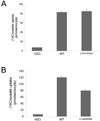Phenotypic and functional analysis of human SLC26A6 variants in patients with familial hyperoxaluria and calcium oxalate nephrolithiasis
- PMID: 18951670
- PMCID: PMC2710965
- DOI: 10.1053/j.ajkd.2008.07.041
Phenotypic and functional analysis of human SLC26A6 variants in patients with familial hyperoxaluria and calcium oxalate nephrolithiasis
Abstract
Background: Urinary oxalate is a major risk factor for calcium oxalate stones. Marked hyperoxaluria arises from mutations in 2 separate loci, AGXT and GRHPR, the causes of primary hyperoxaluria (PH) types 1 (PH1) and 2 (PH2), respectively. Studies of null Slc26a6(-/-) mice have shown a phenotype of hyperoxaluria, hyperoxalemia, and calcium oxalate urolithiasis, leading to the hypothesis that SLC26A6 mutations may cause or modify hyperoxaluria in humans.
Study design: Cross-sectional case-control.
Setting & participants: Cases were recruited from the International Primary Hyperoxaluria Registry. Control DNA samples were from a pool of adult subjects who identified themselves as being in good health.
Predictor: PH1, PH2, and non-PH1/PH2 genotypes in cases.
Outcomes & measures: Homozygosity or compound heterozygosity for SLC26A6 variants. Functional expression of oxalate transport in Xenopus laevis oocytes.
Results: 80 PH1, 6 PH2, 8 non-PH1/PH2, and 96 control samples were available for SLC26A6 screening. A rare variant, c.487C-->T (p.Pro163Ser), was detected solely in 1 non-PH1/PH2 pedigree, but this variant failed to segregate with hyperoxaluria, and functional studies of oxalate transport in Xenopus oocytes showed no transport defect. No other rare variant was identified specifically in non-PH1/PH2. Six additional missense variants were detected in controls and cases. Of these, c.616G-->A (p.Val206Met) was most common (11%) and showed a 30% reduction in oxalate transport. To test p.Val206Met as a potential modifier of hyperoxaluria, we extended screening to PH1 and PH2. Heterozygosity for this variant did not affect plasma or urine oxalate levels in this population.
Limitations: We did not have a sufficient number of cases to determine whether homozygosity for p.Val206Met might significantly affect urine oxalate.
Conclusions: SLC26A6 was effectively ruled out as the disease gene in this non-PH1/PH2 cohort. Taken together, our studies are the first to identify and characterize SLC26A6 variants in patients with hyperoxaluria. Phenotypic and functional analysis excluded a significant effect of identified variants on oxalate excretion.
Figures






Comment in
-
Oxalate transport as contributor to primary hyperoxaluria: the jury is still out.Am J Kidney Dis. 2008 Dec;52(6):1031-4. doi: 10.1053/j.ajkd.2008.10.004. Am J Kidney Dis. 2008. PMID: 19026355 No abstract available.
References
-
- Johnson CM, Wilson DM, O’Fallon WM, Malek RS, Kurland LT. Renal stone epidemiology: a 25-year study in Rochester, Minnesota. Kidney Int. 1979;16:624–631. - PubMed
-
- Soucie JM, Thun MJ, Coates RJ, McClellan W, Austin H. Demographic and geographic variability of kidney stones in the United States. Kidney Int. 1994;22:893–899. - PubMed
-
- Hiatt RA, Friedman GD. The frequency of kidney and urinary tract diseases in a defined population. Kidney Int. 1982;22:63–68. - PubMed
-
- Herring LC. Observations on the analysis of ten thousand urinary calculi. J Urol. 1962;88:545–562. - PubMed
-
- Goldfarb DS, Fischer ME, Keich Y, Goldberg J. A twin study of genetic and dietary influences on nephrolithiasis: a report from the Vietnam Era Twin (VET) Registry. Kidney Int. 2005;67:1053–1061. - PubMed
Publication types
MeSH terms
Substances
Grants and funding
LinkOut - more resources
Full Text Sources
Other Literature Sources
Medical

